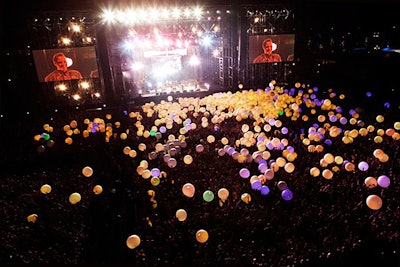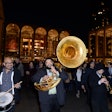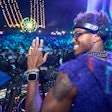
We live in an age of music festivals. From South by Southwest to Lollapalooza, from Bonnaroo to the Great GoogaMooga, consumers go to see their favorite bands and discover new ones, and marketers go to reach the musicians and their fans with sponsor activations and parties.
And more are on the way. Last year, the Coachella Valley Music and Arts Festival split into two consecutive weekends and created an at-sea version on a cruise ship to the Bahamas. Also launched in 2012 and returning this year are Crossing Brooklyn Ferry (this weekend in Brooklyn), the Great GoogaMooga (also in Brooklyn), and Made in America (curated by Jay-Z in Philadelphia).
So how can festivals continue to draw crowds, talent, and sponsors in an increasingly crowded marketplace?
That was one of the topics at a mini conference put together by the team behind a new music, food, and arts festival set to debut in Las Vegas in October, called Life Is Beautiful. Founder Rehan Choudhry, C.E.O. of Aurelian Marketing Group; Joey Vanas, a managing partner of First Friday Las Vegas; and event firm Catalyst Creativ hosted the gathering as part of a monthly speaker series in downtown Las Vegas called Catalyst Week. A group of about 25 people who work in music, advertising, public relations, events, and fund-raising—all big music fans, too—participated in a series of presentations and informal conversations about festival culture. Here are some of the ideas they discussed. (Disclosure: I participated in the conference and stayed in an apartment furnished by the hosts, as did other participants.)
1. Make them free
"Here's my beef with festivals," said marketing consultant Ashley Bekton of Bekton Media Group. "They have gotten really expensive." (She used an expletive in there for emphasis, too.)
The focus of her talk was an idea she calls "URL": ubiquity first, revenue later. That means giving away your core competency for free to let people experience your product or service, and then—after you've drawn a large audience—charging around it. A successful example: Justin Timberlake's new album, The 20/20 Experience, sold 980,000 copies in its first week, 63 percent more copies than RCA, his record label, expected, after it streamed for free on iTunes the week before its release. He goes on tour with Jay-Z this summer to make more money on tickets and merchandise.
Bekton recalled attending one of the Live Aid concerts in Philadelphia in 1985, watching the crowd's excitement when Freddie Mercury took the stage, and feeling she was part of an enormous, international event. In contrast, today's festivals feel less important. "Why are we not making this ubiquitous?" she asked.
The suggestion: While forgoing ticket sales means lost revenue, maybe drawing larger crowds—or, say, online viewers—could create larger sponsorship opportunities that more than make up for the loss.
2. Make them more unique
While some festivals showcase long lists of bands, there are only so many big-draw headliners and hot bands at any given moment. So you see some familiar faces on lineups. This year Phoenix is playing Coachella, the Sweetlife Festival outside Washington, the Grove Music Festival in Toronto, Lollapalooza in Chicago, and Made in America in Philadelphia. The Yeah Yeah Yeahs played Coachella and SXSW and will play at the Great GoogaMooga and the Sweetlife Festival.
A panel of music industry pros suggested showcasing performances that go beyond the same set that a band performs night after night, in venue after venue. "We need more collaborations, more unique experiences," said Sean Glass of Win Music and Glassnote Records.
"Live music performance lacks innovation," said Jesse Israel, a co-founder of Cantora Records. He's developing a festival that would create unusual, one-time collaborations. "Let's find a way to make a music festival where each of the bands will perform with a different technology." A biomedical company, say, could use a device to measure heart rates and incorporate them into lighting and projections. An audience's aggregate heart rate could set the beat of the song.
3. Make sponsorships more organic
Attendees don't go to festivals to interact with marketers. But that doesn't mean sponsors can't add value to the experience.
In his talk, Nathanial Whittemore, strategy lead at Sponsorfied, which connects event properties and sponsors, spoke about the need for festival producers to work with sponsors to create innovative, interactive activations. "The best brands tell us a story about the world that allows us to see ourselves in it," he said. Event hosts should co-create those stories with their partners.
His favorite examples: At TED2012, Genentech had attendees swab their cheeks for DNA samples and the next day gave them buttons that played MP3 files influenced by their genetic markers. At SXSW, Spotify hosted a casual hangout spot where attendees could see musicians play in an intimate setting doing things like charging their phones.
Tom Flanagan, executive vice president of entertainment at Leo Burnett, echoed that idea: "It's very important our brands are innovating around human behavior, not around products and services."
4. Involve the locals
Some festivals drop into a location with no concern for the people who live around their venue. But because one of the core goals of Life Is Beautiful is to bring people to downtown Las Vegas, a big discussion point was the impact of a festival on its local community.
Karla Ballard, a senior vice president at Ogilvy & Mather, suggested that producers should involve the community from the beginning of their planning and invite residents to discuss ideas.
Pat Christiansen, president of Las Vegas Events, and Betsey Fretwell, Las Vegas city manager—who made it clear they both value the economic impact of large festivals—suggested that this type of consideration can help when producers need assistance from local government officials. And it also helps market the event to potential ticket buyers who live nearby and are perhaps most likely to attend.
5. Create a community
In a rousing talk, Choudhry spoke about the genesis of Life Is Beautiful and what drives people to go to festivals. "We are part of the festival generation," he said. Beyond the bands, attendees also want to connect with like-minded people. As consumers use social media and other digital platforms to connect with one another, they're also craving face-to-face gatherings where they create temporary communities.
"We're not creating experiences for people," he said. "These groups of people are demanding experiences from us." As people looking to create their own communities can do so more and more online, event producers need to find ways to connect people.
Peter Shapiro, the owner of Brooklyn Bowl, spoke about how he tries to make his venues feel like festivals. When he ran the New York music club Wetlands, he said the venue’s poor sight lines led people at the bar—who couldn’t see the band performing—to interact with their fellow music fans. When he opened Brooklyn Bowl, he felt he should incorporate something besides music. "I don't really love bowling that much,” he said. “It was more to add to the music."



















